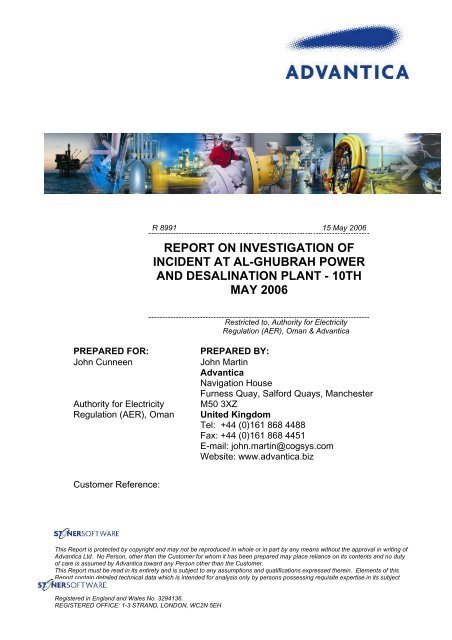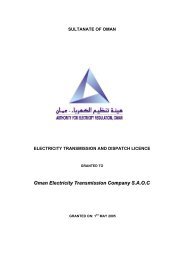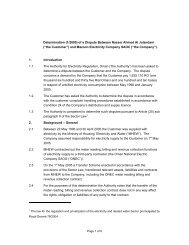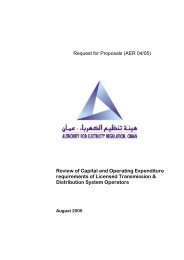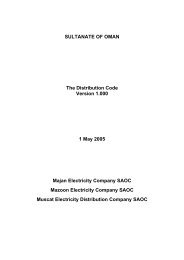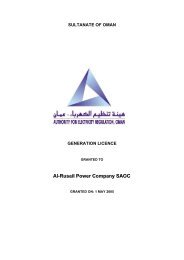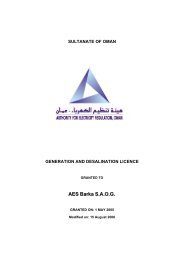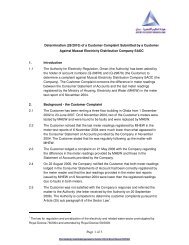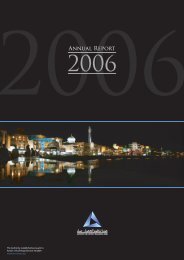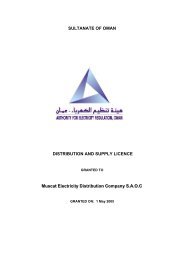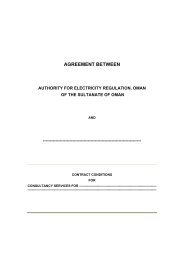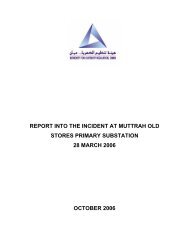GhubrahIncidentInves.. - authority for electricity regulation, oman
GhubrahIncidentInves.. - authority for electricity regulation, oman
GhubrahIncidentInves.. - authority for electricity regulation, oman
Create successful ePaper yourself
Turn your PDF publications into a flip-book with our unique Google optimized e-Paper software.
R 8991 15 May 2006<br />
REPORT ON INVESTIGATION OF<br />
INCIDENT AT AL-GHUBRAH POWER<br />
AND DESALINATION PLANT - 10TH<br />
MAY 2006<br />
Restricted to, Authority <strong>for</strong> Electricity<br />
Regulation (AER), Oman & Advantica<br />
PREPARED FOR:<br />
John Cunneen<br />
Authority <strong>for</strong> Electricity<br />
Regulation (AER), Oman<br />
PREPARED BY:<br />
John Martin<br />
Advantica<br />
Navigation House<br />
Furness Quay, Sal<strong>for</strong>d Quays, Manchester<br />
M50 3XZ<br />
United Kingdom<br />
Tel: +44 (0)161 868 4488<br />
Fax: +44 (0)161 868 4451<br />
E-mail: john.martin@cogsys.com<br />
Website: www.advantica.biz<br />
Customer Reference:<br />
This Report is protected by copyright and may not be reproduced in whole or in part by any means without the approval in writing of<br />
Advantica Ltd. No Person, other than the Customer <strong>for</strong> whom it has been prepared may place reliance on its contents and no duty<br />
of care is assumed by Advantica toward any Person other than the Customer.<br />
This Report must be read in its entirety and is subject to any assumptions and qualifications expressed therein. Elements of this<br />
Report contain detailed technical data which is intended <strong>for</strong> analysis only by persons possessing requisite expertise in its subject<br />
matter.<br />
Registered in England and Wales No. 3294136.<br />
REGISTERED OFFICE: 1-3 STRAND, LONDON, WC2N 5EH
Report Number: R 8991<br />
Issue: 1.1<br />
Executive Summary<br />
A serious incident occurred at Al Ghubrah Power and Desalination Plant, Muscat, on<br />
9 th May 2006, which resulted in fatal injuries to two Sogex employees whilst<br />
per<strong>for</strong>ming maintenance activities on the Phase 3 ‘D’ Hypochlorite storage cylinder.<br />
Following the incident the AER requested Advantica to visit the site of the incident to<br />
carry out a site inspection and to conduct an evaluation of the probable cause of the<br />
incident.<br />
The Advantica visit took place on 10 th May 2006. A verbal debriefing was conducted<br />
at the AER offices with the Executive Director, and a document was prepared <strong>for</strong><br />
issue to all sites following the initial site survey and inspections, which stated that no<br />
further work should be carried out on the Hypochlorite cylinders. The timetable <strong>for</strong><br />
the issue of this report was also discussed during the debriefing.<br />
The principle cause of the incident at Al Ghubrah was a systemic failure of the<br />
Permit to Work (PTW) system. ‘Hot’ work involving the use of electrical tools to<br />
repair a section of the cylinder structure was allowed to take place under a<br />
work order which referenced a ‘cold’ PTW. The ‘cold’ permit had been raised<br />
previously to cover painting activities, and stated that no isolations, draining or<br />
venting were required. The subsequent cylinder repair work should have been the<br />
subject of a proper Risk Assessment which would have identified the need <strong>for</strong> the<br />
work to be carried out under a ‘hot’ PTW with suitable gas detection and other safety<br />
precautions, including necessary isolations and proper venting. The source of<br />
ignition was in all probability the use of an electric drill (not fit <strong>for</strong> purpose - drill<br />
brushes causing sparks in hazardous area, electrical connections badly made etc.)<br />
in proximity to ‘D’ cylinder vent (not isolated and in service at the time).<br />
There were no job-specific fire precautions (i.e. Portable fire extinguishers) in<br />
place.<br />
A new rigorous PTW system is required urgently <strong>for</strong> the Al Ghubrah site. Risk<br />
Assessments should be carried out prior to all activities. The safety<br />
department should be involved at all stages of an activity.<br />
Scaffolding construction and inspection standards should be reviewed as soon as<br />
possible. Although not a direct contributory factor to the incident, the poor standards<br />
observed could be a danger to health and safety in their own right.<br />
Page i
Report Number: R 8991<br />
Issue: 1.1<br />
Project Code: AER May 2006<br />
Distribution<br />
Name<br />
Company<br />
John Cunneen Authority <strong>for</strong> Electricity<br />
Regulation (AER), Oman<br />
Document Authorisation<br />
Name Signature Date<br />
Author (s)<br />
Reviewers<br />
QA<br />
John Martin<br />
Sikobe Litaba<br />
Rebecca Gavin<br />
Ian Mather<br />
Authorisation<br />
Sikobe Litaba<br />
Page ii
Report Number: R 8991<br />
Issue: 1.1<br />
Contents<br />
1 INTRODUCTION................................................................................................. 4<br />
2 FINDINGS........................................................................................................... 5<br />
3 PROCESS .......................................................................................................... 6<br />
4 PROBABLE CAUSE .......................................................................................... 6<br />
4.1 Inadequate Permit to Work considerations.......................................... 6<br />
4.2 Probable source of ignition ................................................................... 6<br />
4.3 Related Observations............................................................................. 6<br />
5 CONCLUSIONS.................................................................................................. 7<br />
6 RECOMMENDATIONS....................................................................................... 8<br />
APPENDIX A LOA NO. 10795/L.......................................................................... 9<br />
APPENDIX B LO 42/04/06................................................................................. 10<br />
APPENDIX C PTW/LOA AUTHORISATION .................................................... 11<br />
Page iii
Report Number: R 8991<br />
Issue: 1.1<br />
1 INTRODUCTION<br />
Following a serious incident at Al Ghubrah Power and Desalination Plant, Muscat,<br />
which resulted in fatal injuries to two Sogex employees (Sogex are the principal<br />
Operation and Maintenance contractor) whilst per<strong>for</strong>ming maintenance activities on<br />
the ‘D’ Hypochlorite cylinder, the AER requested Advantica to visit the site of the<br />
incident to carry out an evaluation of the circumstances and the probable cause of<br />
the incident.<br />
On 9 th May 2006 at 0825 hours, two Sogex employees were involved in the<br />
replacement of cladding on the ‘D’ Hypochlorite cylinder when an explosion occurred<br />
that resulted in the two employees receiving serious external burns, and also serious<br />
respiratory problems due to inhalation of the gases during the explosion. Both<br />
employees subsequently died from their injuries.<br />
On 10 th May 2006 Advantica principal engineer Mr. John Martin (the author of this<br />
report) visited the scene of the incident and met with Sogex senior management<br />
personnel. The investigations carried out and detailed in this report should not be<br />
deemed to be in lieu of any police and/or insurance investigative processes. The<br />
following details a brief report on the findings of the interviews of the Sogex<br />
personnel and a survey of the scene of the accident.<br />
Page 4 / 11
Report Number: R 8991<br />
Issue: 1.1<br />
2 FINDINGS<br />
On arrival at site, Senior Sogex personnel (including the site General Manager) were<br />
interviewed to determine the circumstances and the probable root cause of the<br />
incident. Work permits, work orders, procedures, evidence of competencies and<br />
health and safety documents were requested and received. The author received full<br />
and open co-operation from Sogex personnel throughout the investigation.<br />
On the 25/03/06, a Limitation-of-Access (LOA) Permit-To-Work (PTW), LOA<br />
No.10795/L was issued to carry out routine maintenance on the external surfaces of<br />
the Phase 3 Hypochlorite Storage Tanks, C and D (See Appendix A). The permit<br />
was issued <strong>for</strong> (1) cleaning, (2) surface preparation and (3) painting. The cylinders<br />
were to be left in service and the permit clearly states that no isolations were to be<br />
carried out and that the civil department (conducting the painting operation) were to<br />
take all safety precautions. In this respect this specific PTW/LOA covered activity of<br />
a ‘cold’ work nature, although it is observed that the relevant section of the permit<br />
designed to indicate ‘hot’ or ‘cold’ status was left unspecified.<br />
On inspection of the job site on cylinder ‘D’, the civil department reported that the<br />
cylinder jacket was badly corroded and hence a work order (Reference No. LO<br />
42/04/06) was raised on 05/04/06 to the Mechanical Department, to replace the<br />
cladding (hood) on cylinders A, B, and D (See Appendix B). The work order No. LO<br />
42/04/06 references PTW/LOA No. 10795/L.<br />
Evidence was requested regarding the competency and authorisation of the permit<br />
issuer and work order issuer. Sogex personnel produced relevant CVs and<br />
authorisation memos stating that the persons concerned had been assessed and<br />
found competent to sign permits (see Appendix C).<br />
The work to replace the cladding involved the removal of the corroded cladding and<br />
the fabrication and installation of replacement cladding. To replace the cladding it is<br />
necessary to use drills <strong>for</strong> the riveting process.<br />
It appears that the mechanical fitters were left to complete the work with no periodic<br />
site inspections by the management and no safety departmental presence.<br />
Work on the ‘C’ Hypochlorite cylinder had been per<strong>for</strong>med under a separate internal<br />
work order (LO 37/03/06, not included in this report), without incident. However,<br />
during the process of installing the newly fabricated hooding of the ‘D’ cylinder, an<br />
explosion occurred resulting in a ‘fire ball’ that fatally injured the two Sogex<br />
maintenance fitters involved. They reportedly were able to climb down from the top<br />
of the cylinder, a difficult feat, to seek assistance.<br />
Once the incident had been discovered, the Hypochlorite plant was shut down and<br />
the two employees were immediately transferred to hospital where they were placed<br />
in intensive care, but subsequently passed away.<br />
Page 5 / 11
Report Number: R 8991<br />
Issue: 1.1<br />
3 PROCESS<br />
Hypochlorite is used during the desalination process to control bacterial growth<br />
within the system. Hydrogen is a by-product of the process. The Hypochlorite<br />
treatment process separates the majority of the hydrogen in separators prior to being<br />
pumped into the hypochlorite storage cylinder. Each cylinder is allowed to vent to<br />
atmosphere, and to assist the ventilation process, three fans, two running and one in<br />
standby are used, common to the four cylinders. Although the majority of the<br />
hydrogen is separated, prior to storage, there still remains a ‘trace’ level. The ‘D’<br />
hypochlorite cylinder was reportedly 80% full (liquid) allowing the remaining head<br />
space to fill with hydrogen separated from the hypochlorite be<strong>for</strong>e venting to<br />
atmosphere. Note, the cylinders vent to atmosphere and are there<strong>for</strong>e not classed as<br />
pressurised vessels.<br />
4 PROBABLE CAUSE<br />
4.1 Inadequate Permit to Work considerations<br />
Permit PTW / LOA No. 10795/L does not state whether it is a hot or cold permit to<br />
work, neither box is ticked. However, the wording on the permit indicates that it was<br />
considered to be a ‘cold’ PTW covering the cylinder painting activity only. Under a<br />
‘cold’ permit to work the painters contacted mechanical maintenance to assess and /<br />
or replace the hooding on the four hypochlorite cylinders. Work order No. LO<br />
42/04/06 was issued and progressed <strong>for</strong> Tanks A, B and D with reference to LOA<br />
No. 10795/L with no Risk Assessment evident. Repair maintenance to Cylinder ‘C’<br />
was completed without incident under a separate Work Order LO 37/03/06 (not<br />
included). During the maintenance activities on the ‘D’ cylinder the two maintenance<br />
fitters were using an electric drill in proximity to the cylinder vent, where the<br />
probability of hydrogen gas being present should have been considered to be the<br />
norm, and there<strong>for</strong>e a significant risk to health and safety given the work involving a<br />
potential source of ignition.<br />
4.2 Probable source of ignition<br />
The electric drill being used at the time of the incident was of a standard ‘DIY’ type<br />
with the original plug removed and ‘taped’ to extension cord with a 13 amp, standard<br />
3-pin domestic plug. The plug was inserted into an extension lead drum (still coiled<br />
(not good practice)) with an industrial plug fitted. An electric drill will always issue<br />
sparks from the brushes and in all probability a spark from the drill brushes (or at<br />
least, some similar <strong>for</strong>m of ignition) ignited the hydrogen gas venting from the<br />
hypochlorite tank which caused the hydrogen within the cylinder to explode (gas was<br />
under the constraints of the cylinder) and hence a ‘fire ball’ issued from the vent<br />
causing the fatal injuries to the two maintenance fitters.<br />
4.3 Related Observations<br />
The explosion was of sufficient <strong>for</strong>ce to lift the entire cylinder c. 100mm from its<br />
anchoring bolts and snap a 200mm drainage pipe with pipe wall thickness of c.<br />
12mm.<br />
Page 6 / 11
Report Number: R 8991<br />
Issue: 1.1<br />
There were no job-specific fire precautions (i.e. Portable fire extinguishers) in place.<br />
Also of note, although not a direct contributory factor to the incident, was the poor<br />
conditions of the scaffolding erected to allow work on the cylinder to take place. The<br />
scaffolding had no inspection tags, the scaffold boards were not fixed, the safety rail<br />
(if that is what is was supposed to be) was at knee height, no kick boards were in<br />
place, no secondary means of escape was installed and access to the work area<br />
was by using the cylinders built-on ladder making it difficult to get on and off the work<br />
area.<br />
5 CONCLUSIONS<br />
The principle cause of the incident was a systemic failure of the permit to work<br />
procedure.<br />
Under the directive of a ‘cold’ permit, issued to carry out painting, which clearly<br />
stipulates that isolations were NOT to be carried out, a work order was issued to the<br />
mechanical department to carry out what should have been considered ‘hot’ work<br />
and a new permit considering the new risks should have been required.<br />
There was no evidence of periodic management site inspections being carried out<br />
and there were no representatives of the Safety department.<br />
Risk Assessments were not carried out and the general statement in the procedures<br />
that ‘maintained, where applicable, by the Discipline Engineer who issued the<br />
Internal Work Order. Safety of the employees working on the Internal Work Order is<br />
taken care of’ is clearly insufficient.<br />
The ‘cold’ permit states that ‘civil to take all safety precautions’ in an attempt to place<br />
the safety onus on the employees, rather than the management assessing the risks<br />
involved be<strong>for</strong>e signing.<br />
There should clearly have been a separate permit to work issued following a<br />
thorough Risk Assessment, that insisted upon mechanical and electrical isolations,<br />
draining and venting the cylinder, and gas testing prior to any work commencing.<br />
The work procedures are on the whole generic, and little work has been carried out<br />
to codify tasks and note inherent risks in the differing operation and maintenance<br />
protocols.<br />
The tools in use during the maintenance activities on the hypochlorite cylinders were<br />
not fit <strong>for</strong> purpose (drill brushes causing sparks in hazardous area, electrical<br />
connections badly made, extension lead coiled etc.).<br />
Additionally, the poor condition of the scaffolding erected to allow work on the<br />
cylinder is of concern.<br />
Page 7 / 11
Report Number: R 8991<br />
Issue: 1.1<br />
6 RECOMMENDATIONS<br />
No further work is to be undertaken on the hypochlorite cylinders until a thorough<br />
Risk Assessment has been carried out and a new Permit To Work system has been<br />
instigated that has a check list and calls <strong>for</strong> electrical and mechanical isolations and<br />
gas detections. It should also state that hydrogen gas should always to be assumed<br />
to be present and not expected to be in ‘trace’ amounts only.<br />
No work orders should be allowed to fall under a ‘general’ cold PTW. Each process<br />
should be considered to require a new PTW along with rigorous Risk Assessments.<br />
A Safety representative should be present as the Risk Assessment is being<br />
undertaken and should be a signatory to the permit to work.<br />
If possible, pneumatic tools should be used and where this is not possible, a rigorous<br />
risk analysis and gas detection regime should be in place if electrical tools are to be<br />
used. All tools should be fit <strong>for</strong> purpose and inspected regularly. All portable<br />
electrical devices should fall under a Portable Appliances test regime. If contractors<br />
are used, any tools used should con<strong>for</strong>m to the above standards and should be<br />
verified as part of the permit to work system.<br />
On issuing of a PTW a ‘tool box talk’ should be carried out by the permit issuer to<br />
in<strong>for</strong>m personnel assigned to carry out the activity of the risks involved and ensure<br />
that the risks are fully understood and that all possible safety precautions have been<br />
carried out. During activity, management should periodically inspect the job along<br />
with the safety representative.<br />
The PTW system should be re-assessed regularly by management in liaison with the<br />
safety representatives, operators, and maintenance personnel.<br />
Job site-specific fire risks should be carried out and the correct equipment put in<br />
place prior to work commencing.<br />
Note: A recent independent ISO audit of Al-Ghubrah also pointed out inadequacies<br />
in the PTW system. The Sogex management were, at the time of the incident,<br />
reviewing the PTW system they had received from another operator.<br />
From the author’s brief inspection of this third party PTW system, it appeared to be<br />
on the lines of Al-Ghubrah’s requirement. The new PTW system should be agreed<br />
upon by Sogex management, checked by a third party and instigated with all speed.<br />
Scaffolding construction and inspection regimes should be reviewed and practices<br />
improved as soon as possible.<br />
Page 8 / 11
Report Number: R 8991<br />
Issue: 1.1<br />
APPENDIX A LOA NO. 10795/L<br />
Page 9 / 11
Report Number: R 8991<br />
Issue: 1.1<br />
APPENDIX B LO 42/04/06<br />
Page 10 / 11
Report Number: R 8991<br />
Issue: 1.1<br />
APPENDIX C<br />
PTW/LOA AUTHORISATION<br />
Page 11 / 11


